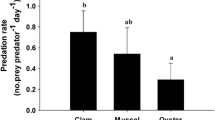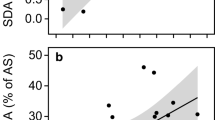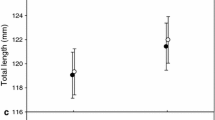Abstract
The interrelationship of fish size, prey size and handling time within a 15-min feeding period was studied in three size groups of 0 + roach, Rutilus rutilus, and bleak, Alburnus alburnus. Four size classes of cladoceran prey were used to measure changes in feeding rate and handling time from initial rapid feeding to sustained feeding. Observed differences in increase of handling time between prey size classes led to a change in the prey profitability ranking of those size classes within the first 2 min of the experiments. A 1-min feeding period is interpreted as reflecting an intermediate motivational status between extreme hunger and satiation. The use of average handling times for this period revealed a substantial change in prey profitability estimates compared to previous studies which used handling times based on short-term (a few seconds up to 1 min) feeding. It is not the largest prey items a fish can handle and swallow that are most profitable, but prey of intermediate size. By this approach a closer fit between expectations derived from optimal foraging theory and empirical data on prey size selection of 0 + zooplanktivorous fish is qualitatively achieved. Optimal prey size was found to be close the mouth gape width in small fish of 15 mm standard length, decreasing to 50% of mouth gape width in fish of 40 mm standard length.
Similar content being viewed by others
References
Begon M, Harper JL, Townsend CR (1986) Ecology. Individuals, populations and communities. Blackwell, Oxford
Bindoo M, Aravindan CM (1992) Influence of size and level of satiation on prey handling time in Channa striata (Bloch). J Fish Biol 40:497–502
Bremigan MT, Stein RA (1994) Gape-dependent larval foraging and zooplankton size-implications for fish recruitment across systems. Can J Fish Aquat Sci 51:913–922
Butler W, Bence JR (1984) A diet model for planktivores that follow density-dependent rules for prey selection. Ecology 65: 1885–1894
Carpenter SR, Kitchell JF (1993) The trophic cascade in lakes (Cambridge studies in ecology). Cambridge University Press, Cambridge
Checkley DM (1982) Selective feeding by Atlantic herring (Clupea harengus) larvae on zooplankton in natural assemblages. Mar Ecol Prog Ser 9:245–253
Confer JL, O'Bryan LM (1989) Changes in prey rank and preference by young planktivores for short-term and long-term ingestion periods. Can J Fish Aquat Sci 46:1026–1032
Confer JL, Mills EL O'Bryan L (1990) Influence of prey abundance on species and size selection by young yellow perch (Perca flavescens). Can J Fish Aquat Sci 47:882–887
Croy MI, Hughes RN (1990) The combined effects of learning and hunger in the feeding behaviour of the fifteen-spined stickle-back Spinachia spinachia L. In: Hughes RN (ed) Behavioural mechanisms of food selection. (NATO ASI Series G vol 20) pp 215–234, Springer, Berlin Heidelberg New York
Croy MI, Hughes RN (1991) The influence of hunger on feeding behaviour and on acquisition of learned foraging skills by the fifteen-spined stickleback, Spinachia spinachia L. Anim Behav 41:161–170
Eggers DM (1977) The nature of prey selection by plaktivorous fish. Ecology 58:46–59
Hansen MJ, Wahl DH (1981) Selection of small Daphnia pulex by yellow perch fry in Oneida lake, New York. Trans Am Fish Soc 110: 64–71
Hart PJB, Gill AB (1993) Choosing prey size: a comparison of static and dynamic foraging models for predicting prey choice by fish. Mar Behav Physiol 23:91–104
Hartmann J (1986) Interspecific predictors of selected prey of young fishes. Arch Hydrobiol Beih 22:373–386
Hirvonen H, Ranta E (1995) Within-bout dynamics of diet choice and variable handling time. in prep.
Holling CS (1966). The functional response of invertebrate predators to prey density. Mem Entomol Soc Can 48:1–86
Kaiser MJ, Westhead AP, Hughes RN, Gibson RN (1992) Are digestive characteristics important contributors to the profitability of prey? A study of diet selection in the fifteen-spined stickleback, Spinachia spinachia L. Oecologia 90:61–69
Kaiser MJ, Hughes RN (1993) Factors affecting the behavioural mechanisms of diet selection in fishes. Mar Behav Physiol 23: 105–118
Kerfoot WC, Sih A (1987) Predation. Direct and indirect impacts on aquatic communities. University Press of New England, Hanover
Kislalioglu M, Gibson RN (1976) Prey “handling time” and its importance in food selection by the 15-spined stickleback, Spinachia sinachia (L.). J Exp Mar Biol Ecol 25:115–158
Krebs JR, Kacelnik A (1991) Decision-making. In: Krebs JR, Davies NB (eds) Behavioural ecology, 3rd edn. Blackwell, Oxford, pp 105–136
Lazzora X (1987) A review of planktivorous fishes: Their evolution, feeding behaviours, selectivities, and impacts. Hydrobiologia 146:97–167
Mangel M, Clark CW (1986) Towards a unified foraging theory. Ecology 67:1127–1138
Mann KH, Britton RH, Kowakzewski A, Lack TJ, Mathews CP, McDonald I (1972) Productivity and energy flow at all trophic levels in the River Thames, England. In: Kajak Z, Hillbricht-Ilkowska A (eds) Productivity problems of freshwaters. PWN, Warsaw, pp 579–596
McNamara JM, Houston AI (1986) The common currency for behavioural decisions. Am Nat 127:358–378
McQueen DJ, Post JR, Mills EL (1986) Trophic relationships in freshwater pelagic ecosystems. Can J Fish Aquat Sci 43: 1571–1581
Mikheev VN (1984): Prey size and food selectivity in young fishes. J Ichthyol 24:66–76
Miller T, Crowder LB, (1990) Effects of changes in the zooplankton assemblage on growth of bloater and implications for recruitment success. Trans Am Fish Soc 119: 483–491
Mills EL, Confer JL, Ready RC (1984) Prey selection by young yellow perch: The influence of capture success, visual acuity, and prey choice. Trans Am Fish Soc 113:579–587
Mills EL, Confer JL, Kretchmer DW (1986) Zooplankton selection by young perch: the influence of light, prey density, and predator size. Trans Am Fish Soc 115:716–725
Nickerson DM, Facey DE, Grossman GD (1989) Estimating physiological thresholds with continuous two-phase regression. Physiol Zool 62:866–887
Northcote TG (1988) Fish in the structure and function of freshwater ecosystems: a “top-down” view. Can J Fish Aquat Sci 45:361–379
Ponton D, Müller R (1990) Size of prey ingested by whitefish, Coregonus sp., larvae. Are Coregonus larvae gape-limited predators? J Fish Biol 36:67–72
Schael DM, Rudstan LG, Post JR (1991) Gape limitation and prey selection in larval yellow perch (Perca flavescens), freshwater drum (Aplodinotus grunniens), and black crappie (Pomoxis nigromaculatus). Can J Fish Aquat Sci 48:1919–1925
Schmitt RJ, Holbrook SJ (1984) Ontogeny of prey selection by black surfperch Embiotoca jacksoni (Pisces: Embiotocidae): the roles of fish morphology, foraging behavior, and patch selection. Mar Ecol Prog Ser 18:225–239
Scott A (1987) Prey selection by juvenile cyprinids from running water. Freshwater Biol 17:129–142
Stephens DW, Krebs JR (1986) Foraging theory (Monographs in behavior and ecology). Princeton University Press,. Princeton
Van den Berg C, Van den Boogaart JGM, Sibbing FA, Lammens EHRR, Osse JWM (1993) Shape of zooplankton and retention in filter-feeding: A quantitative comparison between industrial sieves and the branchial sieves of common bream (Abramis brama) and white bream (Blicca bjoerkna). Can J Fish Aquat Sci 50:716–724
Wahl CM, Mills EL, McFarland WN, DeGisi JS (1993) Ontogenetic changes in prey selection and visual acuity of the yellow perch, Perca flavescens. Can J Fish Aquat Sci 50:743–749
Wanzenböck J (1992) Ontogeny of prey attack behaviour in larvae and juveniles of three European cyprinids. Environ Biol Fish 33:23–32
Wanzenböck J, Schiemer F (1989) Prey detection in cyprinids during early development. Can J Fish Aquat Sci 46:995–1001
Werner EE (1974) The fish size, prey size, handling time relation in several sunfishes and some implications. J Fish Res Bd Can 31:1531–1536
Whiteside MC (1988) O+ fish as a major factor affecting abundance patterns of littoral zooplankton. Verh Int Ver Limmol 23: 1710–1714
Zaret TM (1980) Predation and freshwater communities. Yale University Press, New Haven
Author information
Authors and Affiliations
Rights and permissions
About this article
Cite this article
Wanzenböck, J. Changing handling times during feeding and consequences for prey size selection of 0+ zooplanktivorous fish. Oecologia 104, 372–378 (1995). https://doi.org/10.1007/BF00328373
Received:
Accepted:
Issue Date:
DOI: https://doi.org/10.1007/BF00328373




